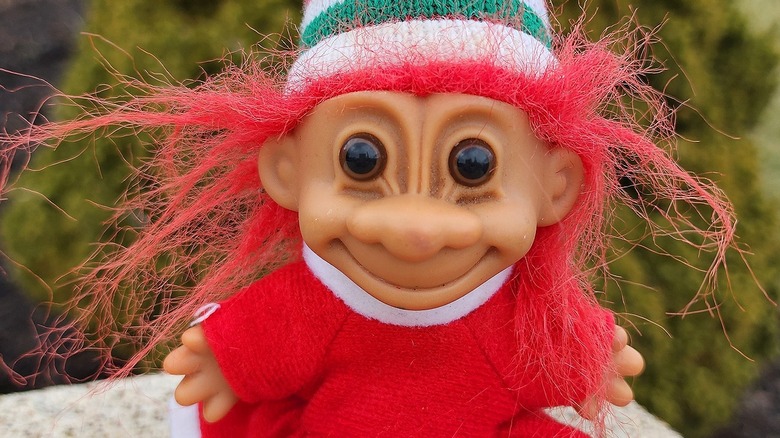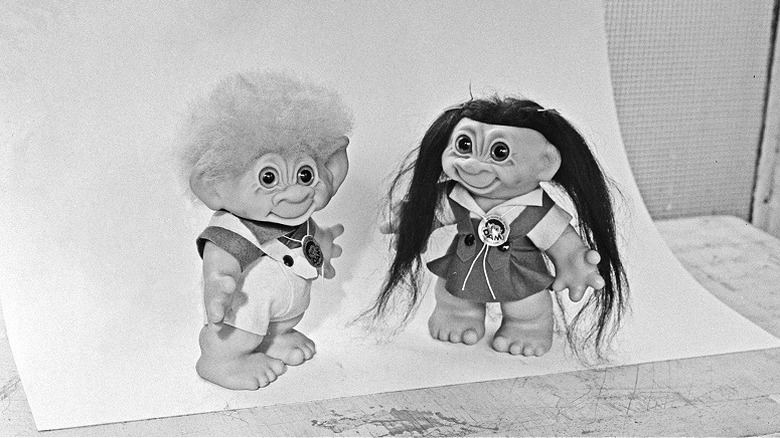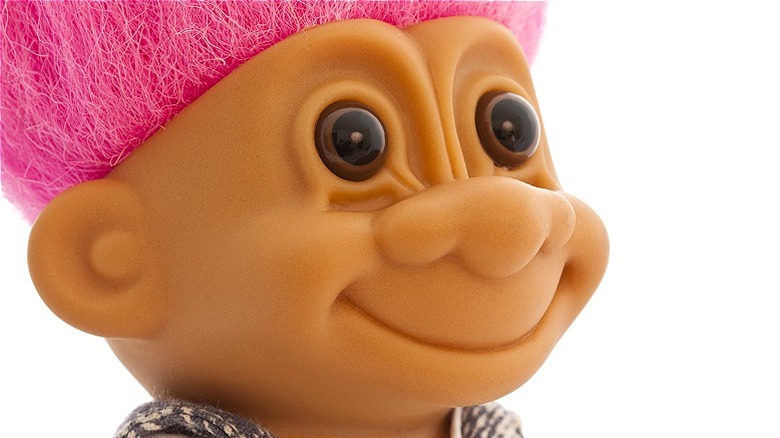Your Old Troll Dolls Might Be Worth A Lot Of Money Today
Troll dolls have been popular long before Anna Kendrick and Justin Timberlake became singing versions in the "Trolls" movies. Ever since the 1960s, kids have loved the strangely sweet faces and stand-up straight hair that make troll dolls so terrifically troll-y. While the lore can vary, pretty much every troll doll promised good luck, plus hours of rainbow hair-stroking fun for the doll's owner — even if that kid didn't know which company made their troll.
Many kids of the 1960s through 1990s might not have known if their troll was from the original brand invented by a Danish baker, or a highly variant knockoff invented by another cash-grabbing toymaker. But what does a child care about the momentary exploitation of weak copyright when the results all look basically the same, and offer so many playtime options?
Looking at a forgotten pile of such troll dolls in your closet might bring to mind the prices of the most rare Furbies, valuable Pokémon cards, or even the oddly adorable faces of Cabbage Patch Kid dolls that are worth a lot of money today. While many troll dolls may be worth their weight in the golden love of a child, which of these charmingly gnarled bits of molded plastic might also fetch some cold, hard, grown-up cash?
A brief history of troll dolls
Thomas Dam never intended to be a toymaker. This Danish baker found himself out of a job after World War II, and he ended up creating the original troll dolls (and elves) for his children and local shops as a hobby while he was in between work. His loved ones urged him to sell his hand-carved figurines inspired by old Scandinavian lore to the public, and eventually, he founded Dam Things.
By the late 1950s, Thomas Dam had a troll doll factory, and by 1962, PVC-molded dolls were made by a network of factories to meet international demand. The Uneeda Doll Company officially licensed and sold Dam's dolls in the U.S. as "Wishnik" troll dolls. However, because of confusing international copyright laws, many other imitations were rushed into production to take advantage of Dam's lack of U.S. copyright. When Dam finally did secure copyright in 1965, a trick of copyright law had already entered the dolls into the public domain, as explained by Quimbee.
Dam dolls and non-Dam trolls have each experienced surges of popularity across generations in America. While a nearby child may be crooning "Trolls" movie songs in 2024, American consumers reportedly spent $100,000 on troll dolls per month by the mid-1960s, per Collectors Weekly. Betty Miller, the first female solo pilot to cross the Pacific in 1963, was even photographed (via LACMA Unframed) celebrating her achievement with President John F. Kennedy and her troll doll flight companion, Dammit.
Some top troll collectibles
A 1960s 3-inch mini-Dam monkey troll doll sold in August of 2024 for $875, while a lot of mini-glitter trolls from Dark Horse in the 1990s sold for $142.50. Trolls in different shapes (like elephants or reindeer) tend to be valuable in the collector's market, as well. Of course, sellers can also sell a lot of good luck trolls to see if other collectors find their troll needle in a haystack. One such lot of a vintage troll mix recently sold for $205.
The beautiful thing about these odd little troll dolls (and their unruly hair) is how every generation hopes to collect the relics of their own past, along with the older, always valuable Dam dolls and Berrie trolls. This provides a range of troll collectibles that could fetch top dollar, whether it's a find from the late 1950s, or the not-so-distant ancient time of the mid-'90s. Per Collectors Weekly, moon trolls, large trolls (that stand over 12 inches tall), and Dam Things dolls from the 1950s and '60s are highly collectible.
Some readers may snicker at the thought that troll dolls may still be collectible. To that, all we can say is, do a quick online search for The Troll Hole Museum in Alliance, Ohio — a place where there are more troll dolls than living beings. Even a quick scan through sold eBay listings shows that the demand for troll dolls (even the newer neon-haired varieties) may never truly cease.


